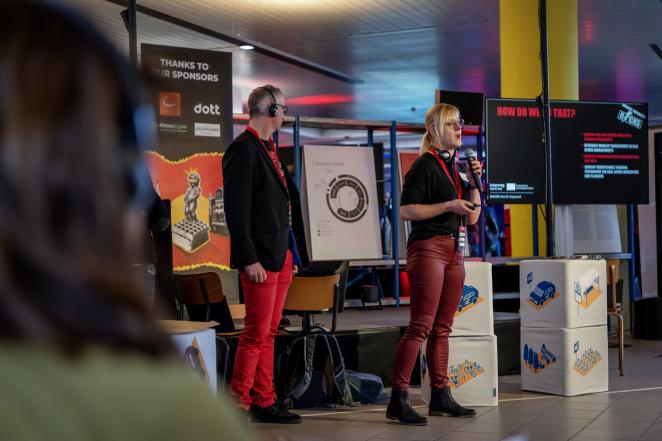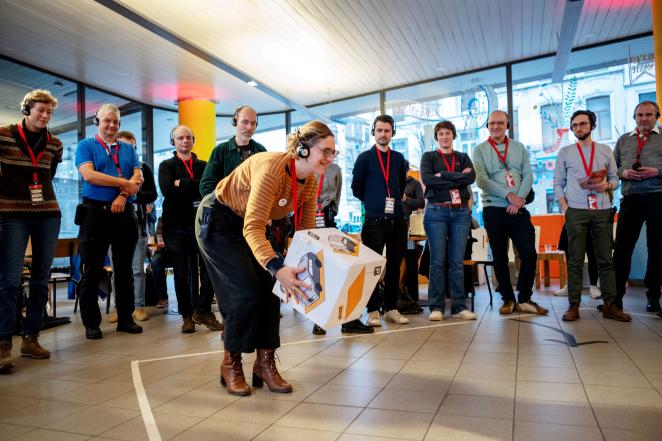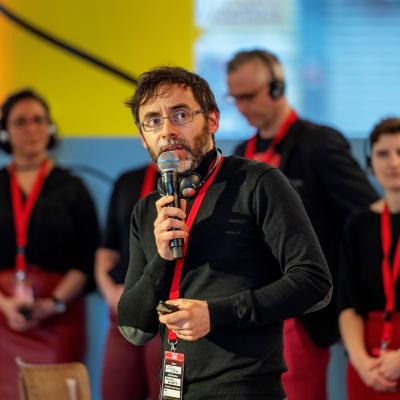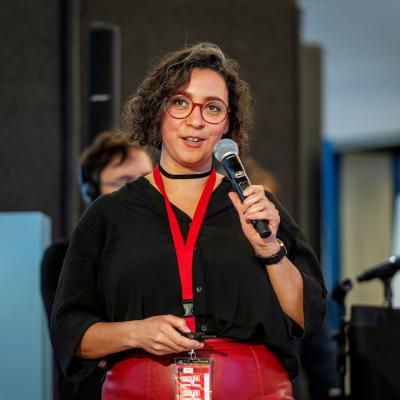This year, the 6th Shared Mobility Rocks Symposium in Brussels was a particularly special one with a true rock festival flair: amazing performers, good vibes, creative and interactive sessions, noise, crowds, food trucks and a healthy dose of chaos. That also goes for the Interreg North Sea Programme SHARE-North Squared project's session at the Symposium – acoustically challenging, a bit chaotic, but interactive and hopefully fun and insightful for the participants! 🤘

The session titled “What can we do with 12 m²?” focussed on the value of space in housing developments and the often unfair allocation of space to private car parking – the average car parking space is, not coincidentally, the size of 12 m². The session started off with short inputs from four different perspectives of various stakeholders surrounding real-estate developments and the parking requirements often imposed on developers after a brief introduction of the SHARE-North Squared Project by Cornelia Cordes.
Key insights from the session:
- Rebecca Karbaumer from the City of Bremen/Freie Hansestadt Bremen started with the question of “What can a city do with 12 m²?” – By creating innovative policies and defining parking bylaws for new development sites that focus on mobility needs rather than car parking (like Bremen’s “Mobilitäts-Bau-Ortsgesetz”), more diverse and flexible mobility concepts can be developed for the needs of users rather than their vehicles. This can also be used to enable cities to make better use of fees paid to a city by developers through purpose- and district-oriented mobility management – for mobility hubs, carsharing memberships, parklets, bikesharing services and more.
- Next, Julien DIJOL from Housing Europe addressed the question “How can 12 m² make a difference for social housing companies and their tenants?” He put it quite simply in his introduction: the ability to reduce car parking requirements for social housing and focus on mobility needs instead, directly contributes to creating more affordable housing. On one hand, because building car parking spaces (particularly when a target group that, on average, has a significantly lower car ownership rate and less demand for parking) is expensive and that cost would otherwise typically need to be passed onto the tenants/buyers. And on the other hand, this frees up space to build more affordable living spaces – the average child’s room in apartment builds is/can be 12 m².
- The question of “How can citizens benefit from 12 m²?” was answered by Michael Johansson from Lund University. If the space of a car parking space – Michael even estimates 20 m² because he considers the hard infrastructure required to access each car parking space as well – was converted to green infrastructure instead, cities and regions could better address the pressing issues of rainwater management, greenhouse gas compensation, the urban heat island effect. In addition to the positive environmental impacts, more green spaces in cities contributes to safety as well as public physical and mental well-being.
- And finally, Esther De Reys from Way To Go (then known as Autodelen.net) addressed the question “What do project developers want with 12 m²?”. The obvious answer would be “to make money”, and indeed, private-sector developers do and must focus on the profitability of their projects. That’s why Way To Go (and other SHARE-North Squared partners) advise real estate project developers on how to integrate shared mobility into their sites to reduce the need for private car parking and, therefore, save on construction costs. There are many best practice examples to be shared already.

But no time for questions! Following the inputs from the speakers and their food for thought, the session dove right into the interactive part. The participants were asked to represent a social housing cooperative with a limited budget for construction of a project in two scenarios:
- Within the context of a parking bylaw whose only options/requirements included only car parking and some bicycle parking,
- Within the context of a mobility bylaw that offered options such as carsharing, bikesharing, cargo bikes, green space integration and more.
After three roles of a special set of dice, Scenario 1 was quickly over budget and had managed to create car parking and a spatial solution that only benefited 10 people from the fictional building project. After three roles of the dice representing parking bylaws with a focus on mobility and not car parking, the project had budget left over and was able to implement the solution of carsharing, bikesharing and a publically accessible parklet for the benefit of all of the participating representatives (45+) AND of all passers-by.
A simple exercise with a clear message: if flexible options that focus on mobility needs rather than car parking are integrated into bylaws for new housing and real-estate developments, a return on investment can be generated as well as a broader value for communities.
Thank you to Way To Go and Mpact for organising the event and the resilience and optimism shown despite “minor” set-backs beyond their control just two weeks before the event. You rock!
Author: Rebecca Karbaumer
Pictures by: Sien Verstraeten ©



